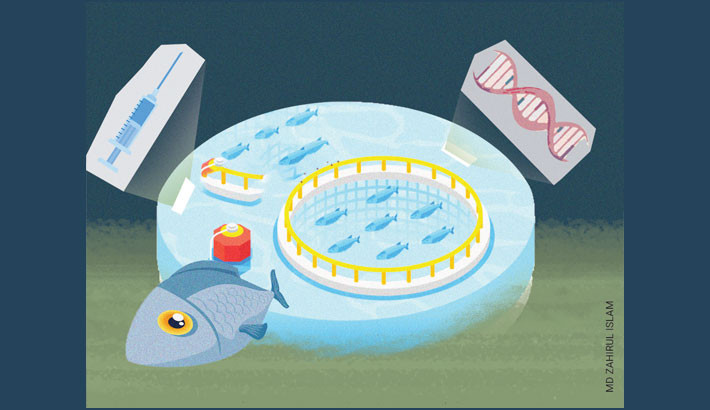
In a bid to safeguard Bangladesh’s aquaculture sector from devastating disease outbreaks, the government has launched a five-year research project worth Tk43.5 crore, aiming to reduce fish mortality by up to 80% through advanced biotechnological studies.
The initiative, led by the Ministry of Fisheries and Livestock and implemented by the Bangladesh Fisheries Research Institute (BFRI), represents a major policy shift towards science-driven aquaculture management.
Over recent years, fish farmers in key aquaculture zones, particularly Mymensingh, Bogura, Rajshahi, and Jashore, have faced a silent catastrophe. Entire pond populations have been wiped out within days due to sudden bacterial and viral disease outbreaks. In some cases, mortality has reached as high as 100%, leaving farmers bankrupt and forcing many out of business.
The new project, titled “Vaccine Development to Prevent Mass Mortality of Freshwater Fish”, will run from July 2025 to June 2030, fully funded by the Government of Bangladesh. Researchers at BFRI will identify the pathogens responsible for these epidemics, isolate their strains, and develop targeted preventive solutions using biomolecular and genomic analysis.
Md Shirajum Monir, Senior Scientific Officer at BFRI, said the project would focus on nine native and commercially important species, including koi, pangas, tilapia, carp, shing, magur, pabda, tengra, and gulsha.
“Currently, farmers lose 70-80% of their fish just before the selling stage due to sudden outbreaks. If we can identify the pathogens and develop preventive tools, we can stop this cycle of loss,” Monir told Daily Sun.
The project also includes field trials across five divisions, 11 districts, and 33 upazilas, with technical collaboration from Malaysia, Thailand, and Indonesia – countries that have already developed oral preventive tools for aquaculture.
Why traditional methods are failing
Fish farmers in Bangladesh have long relied on antibiotics and disinfectants to control diseases. But experts warn that overuse has created drug-resistant bacteria, threatening both the aquaculture ecosystem and public health.
“The drugs we used to depend on are no longer effective. Diseases now spread faster, and water quality is deteriorating,” said Monir.
Antibiotic residues in farmed fish also pose risks to human consumers, potentially leading to antimicrobial resistance (AMR). This has raised serious concerns among food safety experts and export regulators.
Global inspiration, local innovation
Countries such as Chile, Norway, and Malaysia have already succeeded in controlling fish mortality through oral biological methods – a strategy Bangladesh now aims to replicate.
“Oral methods are practical for our farmers because they can be mixed with feed and applied at scale,” said Dr Monir. “We want a low-cost, stress-free, and sustainable solution that works for local conditions.”
The project will use advanced genome sequencing to map bacterial and viral strains in local aquaculture environments, helping scientists understand why conventional methods are failing and how targeted prevention can be more effective.
Economic and nutritional gains
If successful, the project could transform Bangladesh’s aquaculture sector, which currently produces 57% of the country’s total fish output from freshwater farms. With over 4.07 lakh hectares of ponds under cultivation, even a modest improvement in survival rates could generate billions of taka in added value.
Economists say that reducing disease-related losses would not only boost farmers’ confidence but also lower production costs and increase the availability of affordable protein for rural families.
“Reducing mortality even by 50% could save farmers hundreds of crores of taka annually,” said Dr Monir. “It would also help stabilise fish prices and improve food security.”
A model for sustainable aquaculture
Beyond immediate disease control, the project also aims to reduce antibiotic dependency, enhance food safety, and strengthen Bangladesh’s position in regional aquaculture exports. The government plans to commercialise locally developed biological solutions, potentially creating new opportunities in the biotech and feed industries.
Experts, however, caution that farmer adoption and large-scale implementation remain key challenges.
“Scientific breakthroughs must be matched with field-level training and farmer engagement,” said an agricultural economist. “Otherwise, innovations will remain confined to laboratories.”
Still, optimism runs high within the sector.
“This is not just about saving fish,” Dr Monir added. “It’s about protecting livelihoods, nutrition, and the future of our indigenous species.”
____________________________________
The writer is a Senior Reporter at the Daily Sun.
Email: [email protected]

